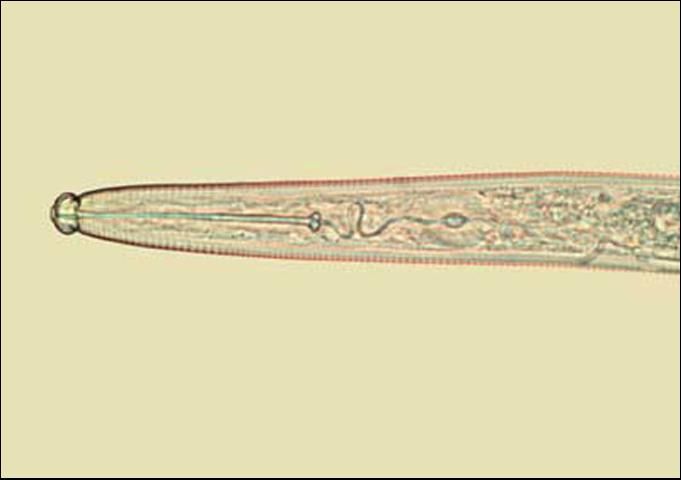The Featured Creatures collection provides in-depth profiles of insects, nematodes, arachnids and other organisms relevant to Florida. These profiles are intended for the use of interested laypersons with some knowledge of biology as well as academic audiences.
Introduction and Distribution
Awl nematodes were first described in 1914 from specimens collected at Silver Springs, Florida, and Douglas Lake, Michigan. Species of Dolichodorus are found worldwide, but two species, D. heterocephalus and D. miradvulvus, are the most common in Florida. Usually, awl nematodes are found in moist to wet soil, low areas of fields, and near irrigation ditches and other bodies of fresh water. Because these nematodes prefer moist to wet soils they rarely occur in agricultural fields and are not as well studied as many other plant-parasitic nematodes.
Importance
Awl nematodes can cause damage as severe as that caused by the sting nematode (Belonolaimus longicaudatus), but because they are generally limited to moist habitats this damage is not as widespread. Awl nematodes have been shown to cause root stunting or reduced yields in many crops including carrots, celery, corn, cotton, beans, cabbage, lettuce, pepper, potato, spearmint, and tomato. In addition they are known to cause damage to some ornamental plants such as impatiens, aquarium plants, and turfgrasses.
Life Cycle and Biology
Adult awl nematodes range in length from about 1.5 mm to 3 mm, making them one of the largest plant-parasitic nematodes. Both sexes are present throughout the life cycle. Eggs hatch after 14 to 17 days. Adults and all juvenile stages feed on roots, sometimes remaining in one spot for up to a week. Awl nematodes can survive in a fallowed greenhouse pot for up to three months.

Credit: Jon Eisenback, Virginia Polytechnic Institute and State University
An ectoparasite, awl nematode feeds on small or large roots, root tips and the hypocotyl. Twelve hours after inoculation, it feeds near the root tip. The cells there become brownish-yellow after several days, and brown lesions form. The result is tissue disorganization, root curvature, and dead or dying root tips.
Symptoms
The damage caused by awl nematodes leads to severe stunting of the entire plant because of depletion of the root system. The roots are often coarse with stubby tips. The few secondary roots that remain are stubby as well.

Credit: Division of Plant Industry
Hosts
Hosts include anubius, balsam, bean, bermudagrass, cabbage, carnation, celery, centipedegrass, corn, cotton, cranberry, hydrilla, impatiens, St. Augustinegrass, sugarcane, tomato, palms, pepper, potato, and water chestnut.
Management
Often awl nematodes are an indicator of excess soil moisture. In some cases improving drainage or reducing irrigation may reduce or eliminate problems with this nematode. Using soil dredged from ditches, ponds, or other water sources to top-dress agricultural fields or to make planting beds may be a source of contamination with awl nematodes. When awl nematodes are present in high numbers this practice should be avoided.
For the most current recommendations for nematode management on a particular crop see the Nematode Management Guide.
Selected References
Christie, J.R. 1959. Plant nematodes, their bionomics and control. University of Florida Agricultural Experiment Station, 216 pp.
Orton Williams, K.J. 1986. Dolichodorus heterocephalus. C.I.H. Descriptions of Plant-parasitic Nematodes. Set 4, No. 56. Commonwealth Institute of Parasitology. C.A.B. International. 3 pp.
Paracer, S.M. 1968. The biology and pathogenicity of the awl nematode, Dolichodorus heterocephalus. Nematologica. 13:517-524.
Perry, V.G. 1953. The awl nematode, Dolichodorus heterocephalus, a devastating plant parasite. Proceedings of the Helminthologia Society of Washington 20:21-27.
Smart, G.C. and N.B. Khoung. 1985. Dolichodorus miradvulvus n. sp. (Nematoda: Tylenchida) with a key to species. Journal of Nematology 17:29-37.
Smart, G.C. and K.B. Nguyen. 1991. Sting and awl nematodes. Pp. 627-668 in W.R. Nickle ed., Manual of agricultural nematology. Marcel Dekker Inc., NY.